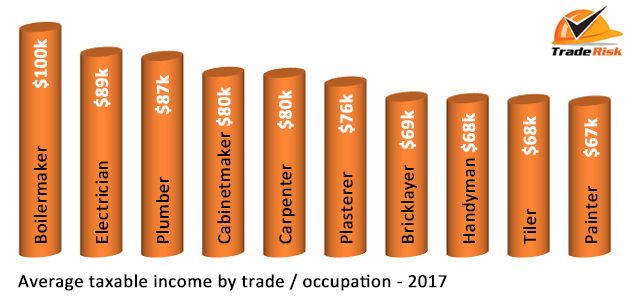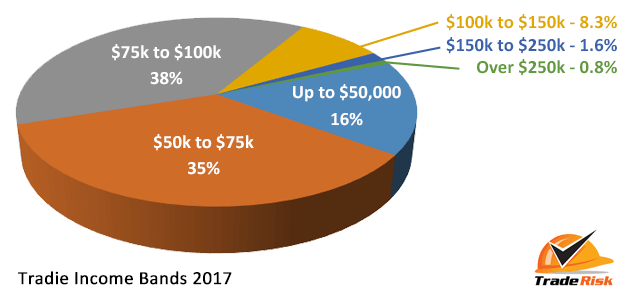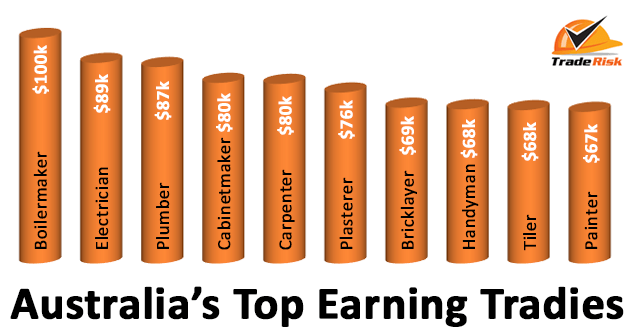This is our 2017 report. To view the current report please click here.
We’re proud to release our 2017 report on how much Aussie tradies earn.
It’s always a hot topic, and this annual report is always one of our most popular each year.
At Trade Risk we are very privileged to see the income figures of thousands of self-employed tradies every year, and that is what enables us to put this report together.
Importantly, our report is based on taxable income, not just turnover or hourly rates like some other reports.
The figures are those which tradies provide for their income protection insurance, which means we are talking taxable personal income.
The Highest Earning Tradies
Whilst our figures cover a very wide number of trades and occupations, we only detail the top 10 trades that we have sufficient numbers for, in order to remain statistically accurate.
So without further ado, here are the top 10 earning trades for the 12 months to November 2017:
Our top two positions swapped place from last year, with boilermakers moving back ahead of electricians.
Boilermakers had topped the report a number of times in the past, but this is the first time they, or any other trade on our list, has cracked $100k.
Before you go saying “I know plenty of boilermakers/sparkies/whatever trade who earn more than $100k”. Yes we know they do, and plenty on our lists do too, but this is an average figure.
| Rank | Change | Trade | Income | Change |
| 1 | +1 | Boilermakers | $100,011 | +22% |
| 2 | -1 | Electricians | $88,974 | +4% |
| 3 | +3 | Plumbers | $87,139 | +10% |
| 4 | +3 | Cabinetmakers | $80,111 | +7% |
| 5 | +3 | Carpenters | $79,652 | +9% |
| 6 | -1 | Plasterers | $75,810 | -5% |
| 7 | -4 | Bricklayers | $69,091 | -16% |
| 8 | +2 | Handymen | $68,389 | +1% |
| 9 | -5 | Tilers | $68,000 | -17% |
| 10 | -1 | Painters | $67,244 | -7% |
Plumbers bounced back up the list, after taking an unusual dive last year. They were the biggest winner, moving up three places from sixth last year to third this year, with an average income of $87,139.
The biggest losers this year were tilers, who dropped five places from fourth to ninth, with an average income of $68,000.
Six of our top 10 trades all saw increases in their average income for the year. The four to suffer a drop included plasterers, bricklayers, tilers and painters.
As always there were a small number of trades and occupations that could have featured in the top ten, however the number of entries were considered too low to be statistically accurate.
These included refrigeration mechanics, air conditioning contractors, concreters, earthmovers, riggers, scaffolders and stonemasons.
Comparison to the national average
Our figures show that the average taxable income for a tradie is $82,766. That’s a strong increase from the $76,800 average we saw last year.
The national average income in Australia, according to the ABS, is $83,616.
That makes our figures for tradies incredibly close to the national average across all occupations and business types, and is the closest it’s ever been in the history of this report.
This gives us a lot of confidence that our figures are very representative of the true earnings of Aussie tradies.
It’s important to remember that our figures include tradies who are predominantly sole traders and subcontractors, whereas the national average from the ABS will include all sorts of outrageously paid people.
For that reason, just because the tradie average is slightly below the national average, it does not mean that a typical tradie earns less than a typical non-tradie.
Overall income bands
An interesting metric to look at each year is what percentage of tradies fit into the different income bands.
The big change this year was that the largest group fell into the $75-$100k range, whereas previous years it has always been the $50-$75k range.
Tradies in the up to $50k range dropped slightly, whilst a large number of tradies in the $50-$75k range moved up into the higher range.
The ranges above $100k were fairly steady, with the exception of the $250k+ tradies who grew significantly, but off a miniscule base of just 0.1%.
Overall the trend continues that the average tradie income is increasing, and across the board tradies are moving up into higher income bands.
A lucky (or should that be hard working) 10% of tradies made it into six figures. This was up slightly on the 9% who reached this figure last year.
Keep in mind that these numbers relate to personal taxable income, or basically the profit of the business.
If you still have $100k after paying all of your business expenses and all of your work-related tax deductions you’re doing well!
Conclusion
If you want to earn more than the national average, each of the trades towards the top of our list will get you there.
Although the other trades in the top ten have average incomes lower than the national average, it’s important to point out that plenty of those tradies are still doing very well for themselves.
For example although carpenters have an average income lower than the national average, our figures included plenty of chippies with incomes over $100k.
By the same token, the figures also included dozens of electricians and plumbers with income below the national average.
The takeaway here is that although some trades do have higher incomes on average, any tradie can earn a great income if they work hard enough and smart enough.
Want to see the previous reports? Follow the links to our 2016 and 2014 reports.
Important information about the figures
When looking at these figures it’s important to get some background on where they’ve come from.
The typical tradesman client of Trade Risk is a subcontractor or sole trader, often working on their own or with just a few staff.
Whilst there will be some clients running large teams and earning very strong six figure incomes, these are certainly not the norm.
It’s also important to note that the figures are based on personal income declared for income protection. So the figures are based on profit, not turnover.
Some tradies may say they ‘earn’ $100k, but if their business expenses are $25k a year then the figure we take is $75k.
We don’t claim that our figures are 100% accurate and reflect every tradesman across every industry.
But what we can say is that the figures have come from over 500 tradies from all states and territories, and based on previous years they appear to be quite consistent across the years.










